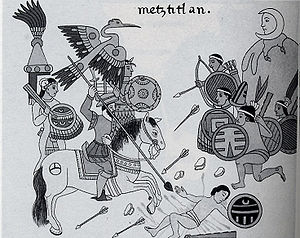Cross-cultural communication is a field of study investigating how people from differing cultural backgrounds communicate, in similar and different ways among themselves, and how they endeavor to communicate across cultures. Intercultural communication is a related field of study.
Acculturation is a process of social, psychological, and cultural change that stems from the balancing of two cultures while adapting to the prevailing culture of the society. Acculturation is a process in which an individual adopts, acquires and adjusts to a new cultural environment as a result of being placed into a new culture, or when another culture is brought to someone. Individuals of a differing culture try to incorporate themselves into the new more prevalent culture by participating in aspects of the more prevalent culture, such as their traditions, but still hold onto their original cultural values and traditions. The effects of acculturation can be seen at multiple levels in both the devotee of the prevailing culture and those who are assimilating into the culture.

Cultural identity is a part of a person's identity, or their self-conception and self-perception, and is related to nationality, ethnicity, religion, social class, generation, locality, gender, or any kind of social group that has its own distinct culture. In this way, cultural identity is both characteristic of the individual but also of the culturally identical group of members sharing the same cultural identity or upbringing. Cultural identity is an unfixed process that is continually evolving within the discourses of social, cultural, and historical experiences. Some people undergo more cultural identity changes as opposed to others, those who change less often have a clear cultural identity. This means that they have a dynamic yet stable integration of their culture.
Cultural assimilation is the process in which a minority group or culture comes to resemble a society's majority group or assimilates the values, behaviors, and beliefs of another group whether fully or partially.
Interculturalism is a political movement that supports cross-cultural dialogue and challenging self-segregation tendencies within cultures. Interculturalism involves moving beyond mere passive acceptance of multiple cultures existing in a society and instead promotes dialogue and interaction between cultures. Interculturalism is often used to describe the set of relations between indigenous and western ideals, grounded in values of mutual respect.
Intercultural communication is a discipline that studies communication across different cultures and social groups, or how culture affects communication. It describes the wide range of communication processes and problems that naturally appear within an organization or social context made up of individuals from different religious, social, ethnic, and educational backgrounds. In this sense, it seeks to understand how people from different countries and cultures act, communicate, and perceive the world around them. Intercultural communication focuses on the recognition and respect of those with cultural differences. The goal is mutual adaptation between two or more distinct cultures which leads to biculturalism/multiculturalism rather than complete assimilation. It promotes the development of cultural sensitivity and allows for empathic understanding across different cultures.

A student exchange program is a program in which students from a secondary school or higher education study abroad at one of their institution's partner institutions. A student exchange program may involve international travel, but does not necessarily require the student to study outside their home country.
Missionary’s kids are the children of missionary parents, and thus born or raised abroad. They form a subset of third culture kids (TCKs). The term is more specifically applied when these children return to their "home" or passport country, and often experience various difficulties identifying with fellow citizens and integrating "back" into their "home" culture. The resulting feeling is described as "reverse culture shock".

Homesickness is the distress caused by being away from home. Its cognitive hallmark is preoccupying thoughts of home and attachment objects. Sufferers typically report a combination of depressive and anxious symptoms, withdrawn behavior and difficulty focusing on topics unrelated to home. Experienced by children and adults, the affected person may be taking a short trip to a nearby place, such as summer camp, or they may be taking a long trip or have moved to a different country.
In anthropology, high-context culture and low-context culture are ends of a continuum of how explicit the messages exchanged in a culture are and how important the context is in communication. The distinction between cultures with high and low contexts is intended to draw attention to variations in both spoken and non-spoken forms of communication. The continuum pictures how people communicate with others through their range of communication abilities: utilizing gestures, relations, body language, verbal messages, or non-verbal messages.

Kalervo Oberg was a Canadian anthropologist. Oberg was dedicated to fieldwork, serving as a civil servant and a teacher. He travelled the world and wrote about these experiences so others could enjoy them as well. Oberg is perhaps best known for applying the term culture shock to all people who travel abroad into new cultures and for his doctoral dissertation, The Social Economy of the Tlingit Indians of Alaska.
Cultural competence, also known as intercultural competence, is a range of cognitive, affective, behavioural, and linguistic skills that lead to effective and appropriate communication with people of other cultures. Intercultural or cross-cultural education are terms used for the training to achieve cultural competence.
The Bennett scale, also called the Developmental Model of Intercultural Sensitivity (DMIS), was developed by Milton Bennett. The framework describes the different ways in which people can react to cultural differences. Bennett's initial idea was for trainers to utilize the model to evaluate trainees' intercultural awareness and help them improve intercultural sensitivity, also sometimes referred to as cultural sensitivity, which is the ability of accepting and adapting to a brand new and different culture.
Integrative communication theory is a theory of cross-cultural adaptation proposed by Young Yun Kim. The first widely published version of Kim's theory is found in the last three chapters of a textbook authored by William Gudykunst with Young Yun Kim as second author. See acculturation and assimilation.
Cultural schema theory is a cognitive theory that explains how people organize and process information about events and objects in their cultural environment. According to the theory, individuals rely on schemas, or mental frameworks, to understand and make sense of the world around them. These schemas are shaped by culture, and they help people to quickly and efficiently process information that is consistent with their cultural background. Cultural schemas can include knowledge about social roles, customs, and beliefs, as well as expectations about how people will behave in certain situations. The theory posits that cultural schemas are formed through repeated interactions and experiences within a particular cultural group, and that they guide behavior in familiar social situations. Cultural schemas are distinct from other schemas in that they are shared among members of a particular cultural group, as opposed to being unique to individuals.

Cultural sensitivity, also referred to as cross-cultural sensitivity or cultural awareness, is the knowledge, awareness, and acceptance of other cultures and others' cultural identities. It is related to cultural competence, and is sometimes regarded as the precursor to the achievement of cultural competence, but is a more commonly used term. On the individual level, cultural sensitivity is a state of mind regarding interactions with those different from oneself. Cultural sensitivity enables travelers, workers, and others to successfully navigate interactions with a culture other than their own.

Identity management theory is an intercultural communication theory from the 1990s. It was developed by William R. Cupach and Tadasu Todd Imahori on the basis of Erving Goffman's Interaction ritual: Essays on face-to-face behavior (1967). Cupach and Imahori distinguish between intercultural communication and intracultural communication.
Third culture kids (TCK) or third culture individuals (TCI) are people who were raised in a culture other than their parents' or the culture of their country of nationality, and also live in a different environment during a significant part of their child development years. They typically are exposed to a greater volume and variety of cultural influences than those who grow up in one particular cultural setting. The term applies to both adults and children, as the term kid refers to the individual's formative or developmental years. However, for clarification, sometimes the term adult third culture kid (ATCK) is used.
Cultural communication is the practice and study of how different cultures communicate within their community by verbal and nonverbal means. Cultural communication can also be referred to as intercultural communication and cross-cultural communication. Cultures are grouped together by a set of similar beliefs, values, traditions, and expectations which call all contribute to differences in communication between individuals of different cultures. Cultural communication is a practice and a field of study for many psychologists, anthropologists, and scholars. The study of cultural communication is used to study the interactions of individuals between different cultures. Studies done on cultural communication are utilized in ways to improve communication between international exchanges, businesses, employees, and corporations. Two major scholars who have influenced cultural communication studies are Edward T. Hall and Geert Hofstede. Edward T. Hall, who was an American anthropologist, is considered to be the founder of cultural communication and the theory of proxemics. The theory of proxemics focuses on how individuals use space while communicating depending on cultural backgrounds or social settings. The space in between individuals can be identified in four different ranges. For example, 0 inches signifies intimate space while 12 feet signifies public space. Geert Hofstede was a social psychologist who founded the theory of cultural dimension. In his theory, there are five dimensions that aim to measure differences between different cultures. The five dimensions are power distance, uncertainty avoidance, individualism versus collectivism, masculinity versus femininity, and Chronemics.
International communication is the communication practice that occurs across international borders. The need for international communication was due to the increasing effects and influences of globalization. As a field of study, international communication is a branch of communication studies, concerned with the scope of "government-to-government", "business-to-business", and "people-to-people" interactions at a global level. Currently, international communication is being taught at colleges worldwide. Due to the increasingly globalized market, employees who possess the ability to effectively communicate across cultures are in high demand. International communication "encompasses political, economic, social, cultural and military concerns".









